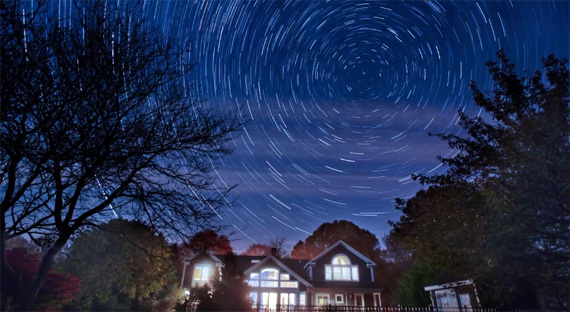Star trails are beautiful, and have an almost surreal look. All you need to photograph star trails is knowledge of the right technique and a bit of patience. If you have wondered how to create strikingly good star trail images, you’re in the right place! In the tutorial shown below, Tony Northrup shares with us the basics of creating beautiful star trail images:

What You Need
To begin with, you’ll need a steady tripod. It’s good to have a bubble level that you can put on top of your camera or an electronic level in your camera, as you won’t be able to see the horizons in the dark.
Use a wide angle lens. The wider the better, as this will help you capture as much of the sky possible. Set your lens to manual focus, and then adjust your focusing to ‘near infinity’.

Star Trail Photography
Camera Settings
Then comes the shutter speed. Keep it at 30 seconds, and then set your aperture to the widest setting. This lets more light in. An aperture of f/3.5 or 4.0 is good enough. Set your ISO at 1600 and take a test shot. After the test shot is done, zoom in and check to see if the stars are sharp, if not re-adjust the focus and keep taking test shots until the stars appear sharp.
Set the shutter for continuous shooting, where you just hold the shutter down and click. It’s a little odd to do that with a 30 second exposure, but it works great. Use remote shutter release to lock the shutter open, otherwise you’ll shake the camera. Your camera will now shoot a new picture every 30 seconds.
Once that is done, transfer the images to the computer. Tony uses Lightroom to process the RAW files, as it allows you to easily apply the same settings to the entire set of images. The images will have an orange tint and bad colors, as happens with most nighttime shots. But this can be corrected. Check the white balance, and correct the exposure settings. You want the stars to be bright and nice, and the sky to be dark. Adjust the black levels and white levels and apply the same settings to the entire set.
After this he exports the set as JPEG files into a single folder and stacks them together.

Exposure Stacking for Star Trail Photography
Things to Remeber
- It’s always advisable to set your camera beforehand in the daylight so that you can see what you’re setting. Once you reach the location, it will be pitch dark. You can hardly see anything, and you won’t know what you’re doing.
- Carry some sort of flashlight or headlight with you.
- Don’t jostle your camera while you’re taking the images. Your camera has to be completely still.
- Check your camera every 10 to 15 minutes. Clean the lens with an absorbent lint-free cloth.
- Keep an eye on the sky, too. Clouds might ruin your images. They might come and go just for a couple of minutes, but they’ll be locked in long exposures.
Hopefully, these tips will you click some amazing photographs. Do share them with us. Good luck and happy trailing!
Like This Article?
Don't Miss The Next One!
Join over 100,000 photographers of all experience levels who receive our free photography tips and articles to stay current:






This is awesome! Thanks for sharing this great article. I’m just introduced in star trail photography and I really want to learn more about it. Good thing is that I found your blog and I really learned a lot from it. Great photographs BTW.
If you are using a wide angle lense, is it really necessary to focus to near infinity? In fact, wouldn’t it be better to be focused to the closest object as infinity will, by the nature of the wide angle lense, be in focus.